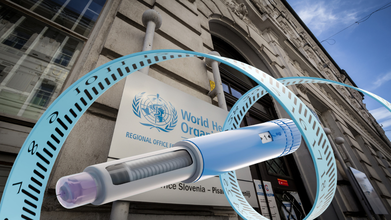- Health Conditions A-Z
- Health & Wellness
- Nutrition
- Fitness
- Health News
- Ayurveda
- Videos
- Medicine A-Z
- Parenting
Loneliness Epidemic. Seoul Is Spending 327 Million To Stop It

Loneliness (Credit: Canva)
South Korea is grappling with a growing emotional pandemic: loneliness. As young people withdraw from society, choosing isolation over connection, the phenomenon known as hikikomori, a Japanese term referring to reclusive individuals, has gained alarming prevalence. In 2022, it was estimated that up to 244,000 South Koreans had withdrawn from the world, spending their lives locked inside their rooms for months at a time.
This withdrawal from social life has stark consequences. The number of "lonely deaths" has also surged, reaching 3,661 last year, up from 3,559 in 2022, and 3,378 in 2021, according to data from the Ministry of Health and Welfare. These figures reflect a sobering reality as an increasing number of South Koreans are dying alone, often unnoticed for extended periods.
Part of the rise in lonely deaths can be attributed to the ministry’s broader definition. In the past, only deaths where bodies were discovered after a significant delay were counted. Now, anyone who dies in social isolation—cut off from family or friends, whether from suicide or illness—is included in the category. This shift highlights the growing crisis of isolation, particularly among middle-aged and elderly men. More than 84% of lonely deaths in 2023 were male, with men in their 50s and 60s accounting for more than half of the total.
South Korea’s demographic trends are further exacerbating the issue. With an aging population and declining birth rates, deaths have consistently outpaced births in recent years, contributing to the overall rise in lonely deaths. Yet, beyond the numbers lies a deeper cultural issue: the struggle with loneliness, which is experienced differently in South Korea compared to other countries.
While loneliness is a universal feeling, it manifests uniquely in South Korea. According to psychology professor An, “Koreans may not necessarily feel lonelier than others, but the reasons behind their loneliness differ.” In many cultures, loneliness stems from unfulfilled relationships, but in South Korea, people often associate loneliness with a lack of purpose or a sense of inadequacy. Many Millennials and Gen Z Koreans are deeply self-critical, afraid of failure, and sensitive to societal expectations.
A 2023 study highlighted that loneliness in Korea is shaped by cultural nuances. Korean society emphasizes relational orientation, meaning people often define themselves in relation to others. As a result, even those with active social lives may feel profound loneliness if they perceive themselves as not contributing meaningfully to society. The intense pressure to achieve, combined with rising single-person households, reduced social interactions, and the dominance of social media, fuels feelings of inadequacy.
“When everyone pursues the same values excessively, we end up losing ourselves,” An explained. “Our society demands highly collective social living but often fails to respect the individual,” leaving many struggling with isolation and failure. As South Korea continues to navigate this emotional crisis, addressing loneliness remains a complex challenge requiring cultural and structural shifts.
WHO Issues First Guidance On Obesity Drugs — GLP-1 Drugs Get the Green Light

Credits: iStock
The World Health Organization (WHO) issued its first-ever recommendation endorsing GLP-1 medications as part of a long term strategy to manage obesity in adults. Earlier, in the guidance to deal with obesity, the main focus was given to diet and lifestyle changes. Thus, this is a big shift from how the UN agency has traditionally approached obesity treatment.
Until now, WHO guidelines only focused on lifestyle changes including physical activity and diet. The new recommendation acknowledges that medication can play a supportive role when combined with counseling on healthy eating and regular exercise.
Published in the Journal of the American Medical Association (JAMA), the guideline describes long-term use as continuous treatment for at least six months. In its note, WHO called obesity a “chronic, relapsing disease” that affects more than one billion people worldwide and contributes substantially to illness, early death, and economic strain on health systems. GLP-1 therapies, the organization wrote, offer “clinically meaningful weight loss and broad metabolic benefits” when used appropriately.
How Do GLP-1 Drugs Work?
GLP-1 drugs mimic the action of the natural hormone GLP-1 to regulate blood sugar and promote weight loss. They work by increasing insulin release in a glucose-dependent manner, decreasing the liver's production of glucagon, and slowing down the emptying of the stomach, which helps lower blood sugar levels after a meal. They also act on the brain to suppress appetite and increase feelings of fullness, leading to reduced calorie intake.
In people with type 2 diabetes, notes Harvard Health, the body's cells are resistant to the effects of insulin and body does not produce enough insulin, or both. This is when GLP-1 agonists stimulate pancreas to release insulin and suppress the release of another hormone called glucagon.
These drugs also act in the brain to reduce hunger and act on the stomach to delay emptying, so you feel full for a longer time. These effects can lead to weight loss, which can be an important part of managing diabetes.
Why WHO’s Guidance Matters
In September, WHO added GLP-1 drugs to its list of essential medicines, but only for treating diabetes, not for obesity alone. The new guideline extends that conversation, offering a more formal stance on their use in obesity management. The recommendations were developed by a committee of experts in obesity, pharmacology, and public health, following requests from several WHO member states. They also align with approvals already granted by regulators like the U.S. Food and Drug Administration.
Obesity: A Global Health Challenge
Obesity is now recognized as one of the most widespread health concerns worldwide, linked to an increased risk of chronic conditions, including cancers, heart disease, and metabolic disorders. Beyond physical health, it also impacts mental well-being and quality of life. With more than a billion people affected globally, the economic burden on healthcare systems continues to grow.
Also Read: Only 1 in 10 People With Obesity Have Access To Popular GLP-1 Weight-Loss Drugs, Says WHO
However, the accessibility still remains a major issue. n the United States, the most widely used medications: Eli Lilly’s Zepbound and Novo Nordisk’s Wegovy, carry list prices exceeding $1,000 per month. Recently, the Trump administration announced agreements with pharmaceutical companies aimed at lowering costs for people paying out of pocket or covered under Medicare or Medicaid.
International Day of Persons with Disabilities 2025: Theme, Origin, Significance

Credits: iStock
Every year on December 3, the International Day of Persons with Disabilities (IDPD) is observed. It is a UN day that works towards promoting the rights and well-being of persons with disabilities at every level of society and development, and to raise awareness of the situation of personal with disabilities in all aspects of life.
At the headquarters of the World Health Organization (WHO), IDPD events are organized to educate the public, raise awareness, advocate for political will and resources, and celebrate WHO's achievement.
Who Are Persons With Disabilities?
As per the United Nations Convention on the Rights of Persons with Disabilities or the UNCRPD, persons with disabilities are individuals with long-term physical, mental, intellectual, or sensory impairments that restrict their ability to participate in society on equal terms.
India’s commitment to accessibility stems from Article 9 of the UNCRPD, which mandates equal access to physical spaces, transportation, and services.
Rights of Persons with Disabilities Act, 2016: India’s RPwD Act, 2016, aligns with this definition and adds the term “benchmark disability,” which refers to individuals with at least 40% of a specified disability.
This Act sets accessibility standards for public spaces and digital platforms.
The Act increased reservation for PwDs from 3% to 4% in jobs and 3% to 5% in higher education.
The RPwD Act expanded the list of disabilities from 7 to 21 categories, including conditions like:
- Autism spectrum disorders.
- Acid attack survivors.
- Multiple sclerosis and chronic neurological conditions.
As per the 2011 Census, India is home to 26.8 million persons with disabilities, which means at least 2.21% of its total population. The highest prevalence is observed between the age group of 10 to 19 years. Among them, 20% have mobility impairments, 19% have visual impairment, 19% have hearing impairment, and 8% suffer from multiple disabilities.
International Day of Persons with Disabilities: Theme
This year, the theme is 'Fostering disability-inclusive societies for advancing social progress, while in 2024, the theme was: 'Amplifying the leadership of persons with disabilities for an inclusive and sustainable future'.
International Day of Persons with Disabilities: Origin
This was first established by the United Nations in 1992, to raise awareness and creating inclusive society for all. The aim was to create an inclusive, accessible, and equitable society where no one is left behind.
International Day of Persons with Disabilities: Significance
The main role of this day in observance is to educate people. As more than 1 billion people in the world, which is around 20% of the world population live with some kind of disability. Thus, in such a scenario it is important for people to be sensitive towards their need. This day also helps address and solve the barriers faced by people living with disabilities, which include:
Limited access to education and employment
Inaccessible public spaces and transportation
Social stigma and discrimination
Insufficient healthcare and rehabilitation services
Lack of assistive technologies and accessible digital platforms
La Toya Jackson's New Photos Spark Health Concerns As She Looks Too 'Petite' In Them

Credits: Instagram
La Toya Jackson’s latest Instagram post has left fans more worried than ever. The 69 year old singer shared a series of photos earlier this week wearing a fitted red top, black pants and gold pointy heels. She added a chunky chain belt and a bracelet, posing in different angles for her followers. But what stood out most was how noticeably thin she looked, especially in the side profile shot.
Her caption was cheerful, wishing everyone a great week and sending love. The comment section quickly filled up, but instead of the usual compliments, many people expressed concern. Some fans urged others to be kind and pointed out that La Toya has always been naturally petite. Others felt something deeper might be going on. One comment read that it seemed like she may be dealing with “some health challenges”.
The post comes just weeks after La Toya shared a short, somewhat cryptic video from what looked like a doctor’s office. She did not explain why she was there but told her followers she hoped all her results would be good.
In another clip she hinted that doctor visits had become frequent, joking that she was “constantly getting check ups”. Despite the glimpses into her medical visits, she has not revealed what health issues she may be facing, leaving fans to worry and speculate.
While her situation remains private, her photos have opened up a larger conversation about what happens when someone becomes extremely thin. Many people assume being skinny is automatically healthy, but that is not always true. There is a point where being underweight can put real strain on the body.
What Really Happens When You Are Too Thin
Being underweight means your body does not have the amount of nutrition and energy stores it needs to function well. One common guideline used by experts is body mass index. For most adults, a BMI below 18.5 is considered underweight. In children and teenagers, being below the 5th percentile for BMI indicates underweight.
Sometimes extreme thinness is easy to spot, but people who have always been slim may not notice when their weight drops into an unhealthy range. Children who are underweight may simply seem smaller or leaner than others their age, which can make early signs easy to miss.
When the body does not get enough nutrients or calories, it begins to show that stress in different ways. Some of the early signs include constant tiredness, weakness, dizziness or feeling lightheaded.
The heart can also slow down, leading to a low pulse and low blood pressure. Hair may become thinner or start falling out and the immune system becomes weaker, which means a person might catch infections more easily and take longer to recover.
Emotional and hormonal changes are also common. Irritability, low mood or a sense of apathy can appear. In women, periods may become irregular or stop completely. Severe underweight can affect fertility and make it harder to get pregnant.
These symptoms do not happen overnight. They develop gradually as the body runs lower on essential nutrients. This is why sudden or unexplained weight loss should always be taken seriously.
© 2024 Bennett, Coleman & Company Limited

